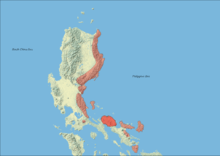Gray's monitor
The Gray's monitor (Varanus olivaceus) is a large (180 cm, >9 kg) monitor lizard known only from lowland dipterocarp forest in southern Luzon, Catanduanes, and Polillo Island, all islands in the Philippines.[1] It is also known as Gray's monitor lizard, butaan, and ornate monitor.[3] It belongs to the subgenus Philippinosaurus.[4] It is largely arboreal and extremely shy. The Northern Sierra Madre monitor lizard was thought to be of same species with Gray's monitor until a research concluded in 2010 that northern populations of Gray's monitor was a distinct species, now known as V. bitatawa.
| Gray's monitor | |
|---|---|
| Scientific classification | |
| Kingdom: | Animalia |
| Phylum: | Chordata |
| Class: | Reptilia |
| Order: | Squamata |
| Family: | Varanidae |
| Genus: | Varanus |
| Subgenus: | Philippinosaurus |
| Species: | V. olivaceus |
| Binomial name | |
| Varanus olivaceus Hallowell, 1856 [2] | |
 | |
| Range of Varanus olivaceus prior to 2010. In 2010, it was found that the northern populations are of distinct and new species. | |
Ecology
Diet
It is well known for its diet, which consists primarily of ripe fruit, especially Pandanus. A number of prey items are, however, also consumed, including snails, crabs, spiders, beetles, birds and eggs. Monitors are generally carnivorous animals, which makes the Gray's monitor somewhat of an exception amongst the varanid family. Such an unusual diet may be as a result of competition over food with the water monitors, which share their range. One of the only fruits readily eaten by this species in captivity is grapes, with these and fruit powder supplementing a captive diet of insects and rodents.[5]
Reproduction
Details of the breeding habits of this species, certainly in the wild, are very limited due to the secretive nature of this species. The optimum egg-laying time for this species is known to be between July and October, when a clutch of up to 11 eggs will be laid. Rather than digging a nest, the most likely place for this species to lay eggs is thought to be in tree hollows, where they also spend much of their days resting. Young are often observed at their smallest in May to July, and as such estimates of incubation time lay at around 300 days. In captivity, however, incubation has been recorded over 219 days.[5]
Conservation
Threats
It is classed as vulnerable by the IUCN because most of its habitat has been destroyed over the last 60 years, and it is now thought to live in an area as small as 20,000 km², of which only around 2,000 km² are occupied by this species. It is thought that habitat destruction is not the only cause for the decreasing population trend, but that they are also still hunted for food and collected for the pet trade.[6] It may be more threatened than initially estimated, since the northern population were confirmed to be of different species (V. bitatawa) in 2010. The range of the species has now been enclosed to the Polillo islands and the southern portions of Luzon, a very fragmented area with sparse rainforests left. A new assessment by the IUCN is highly recommended, as the species may be endangered or critically endangered already.
In captivity
This species is not widely kept in captivity, which is possibly partly because it is not generally bred successfully outside of the Philippines. This species is on display at the following zoos outside the Philippines:
- Los Angeles Zoo
- Oklahoma City Zoo and Botanical Garden
- Protvin Krokozoo[7]
- Wingham Wildlife Park[7]
- Brookfield Zoo[8]
There are two Philippine zoos which are successfully breeding this species, which are Avilon Zoo and Paradise Reptile Zoo. For many years, the only report of a breeding outside of the Philippines was a single baby hatched at the Dallas Zoo in 1994, until the LA Zoo hatched them for the first time in 2015.[9] Dallas gave their two female monitors to the Oklahoma City Zoo in May 2013.
References
- Sy, E.; Afuang, L.; Duya, M.R. & Diesmos, M. (2009). "Varanus olivaceus". IUCN Red List of Threatened Species. 2009: e.T22888A9396856. doi:10.2305/IUCN.UK.2009-2.RLTS.T22888A9396856.en.
- Varanus olivaceus Hallowell, 1856. ITIS.gov
- "Common Names for Ornate Monitor (Viranus Olivaceus)". Encyclopedia of Life. Retrieved 12 December 2013.
- Harold De Lisle. MONITORS OF THE WORLD 1998 LIST. Kingsnake.com
- "Varanus olivaceus". Mampam Conservation. Retrieved 9 February 2013.
- "Red List Entry for Varanus olivaceus". IUCN Red List of Threatened Species. Retrieved 9 February 2013.
- "Gray's Waran". Zoo Tier Liste. Retrieved 9 February 2013.
- "One More Thing: Grey's Monitor". FIRST LIGHT. Retrieved 7 October 2019.
- https://www.earthtouchnews.com/cute-and-cool/zooborns/three-rare-grays-monitor-lizards-hatch-at-los-angeles-zoo/
Bibliography
- Auffenberg, W. 1988. Gray's Monitor Lizard. University of Florida Press, Gainesville
- Bennett, Daniel (2000). "Preliminary survey and status report for Varanus olivaceus on Polillo Island.". In Daniel Bennett (ed.). Wildlife of Polillo Island, Philippines. University of Oxford – University of the Philippines at Los Banos Polillo '99 project. Final report. Glossop: Viper Press. pp. 174 pp. ISBN 0-9526632-5-2.
